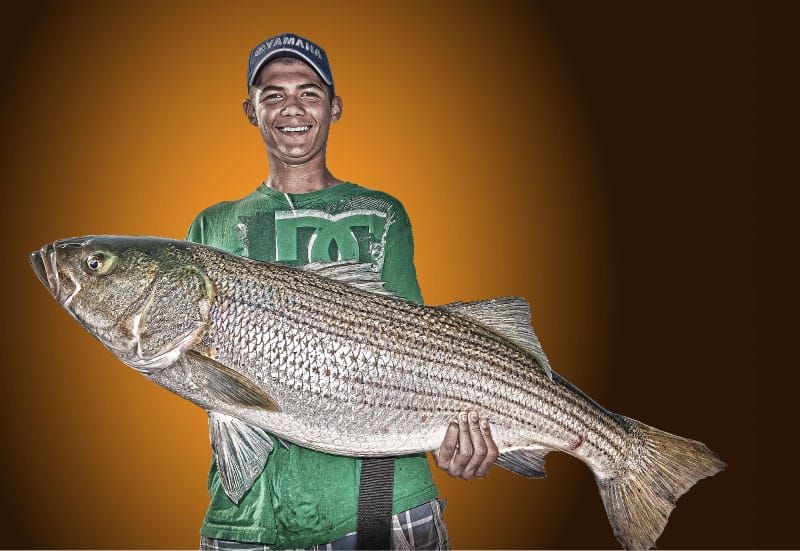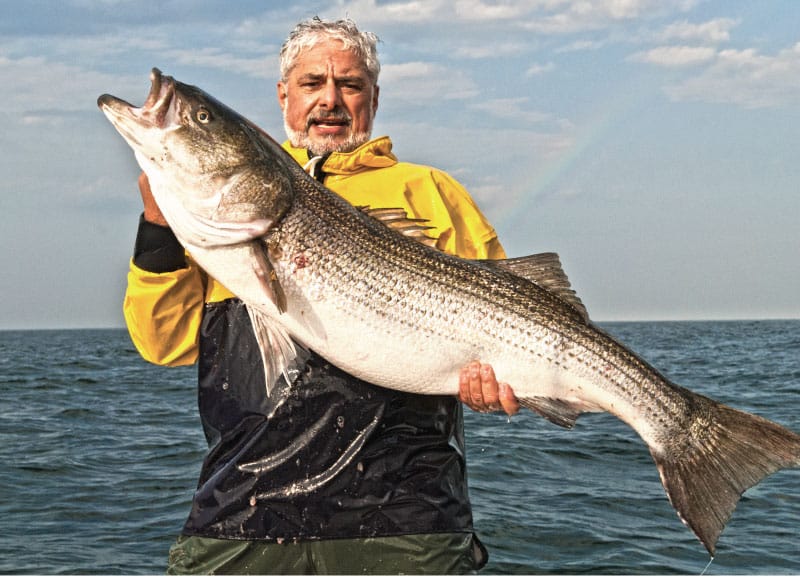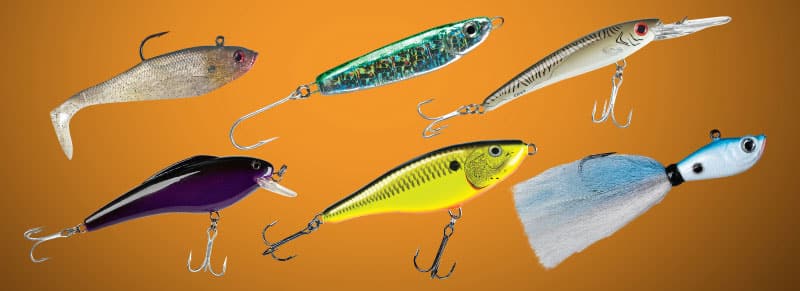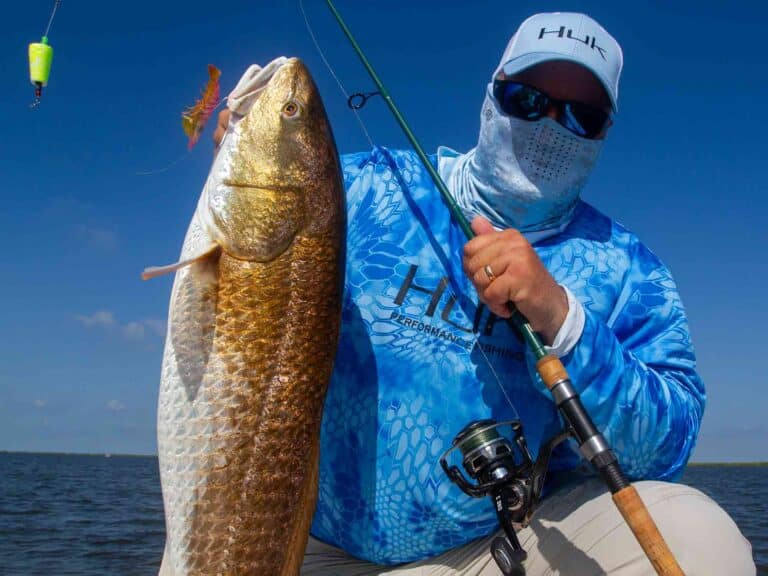The fall run of striped bass out of the Northeast and south along the mid-Atlantic coast presents a wealth of opportunities that can change at a moment’s notice. One day you might be casting to schoolies feeding on mullet along the beach, and the next day, live-lining for trophy-size fish under a pod of menhaden a couple of miles out. The variety of bait migrating between October and January requires your constant attention and quick response to changing conditions. The key to catching bass this time of year depends on capitalizing on opportunities and having the right tackle aboard every time you leave the dock.
Flexibility Is Key
One example that comes to mind occurred in early November a few years back. Californian Bill Goodman, marketing manager of Sevenstrand Tackle, and I left the marina and headed for the inlet, but we got waylaid by a commuter train at the Manasquan River bridge. While waiting, I spied a school of peanut bunker pushed up onto a flat alongside a nearby sedge bank, so I handed Goodman a light spinning outfit armed with a 4-inch paddle-tail shad, and he connected with a 15-pound striper on the first cast. We were having so much fun with the bass that we almost missed the bridge opening. It’s hard to leave fish to go find fish, but I knew there were more and bigger bass along the beach.
About 10 miles south of the inlet, we were treated to the sight of gannets whirling and diving on massive schools of bait driven to the surface by bass and bluefish. Switching over to plugging outfits with baitcasting reels, 30-pound braid and flat-sided jigs, we started yo-yoing under the bait pods. We spent the next few hours getting sore arms fighting bass to 25 pounds and bluefish to more than 15 in some of the most frenetic hours of fishing that year. When the melee broke up, the bait scattered, and I added 10-foot leaders of 50-pound fluorocarbon to the same plugging rods, clipped on a couple of deep-diving swimming plugs and went on the troll, catching and releasing a few more quality bass before calling it a day. The key to the success that day, like on so many others during the fall run, was being prepared for the opportunities that came our way.
Bait Abundance
Fall bass fishing in the mid-Atlantic kicks off in late September or early October with the start of the mullet run. These summertime visitors form dense schools and migrate south along the beach, giving both surf fishermen and boat anglers plenty of shots at plugging stripers.
Following the mullet run, cooling waters start to push young-of-the-year menhaden and other small baitfish like silversides and bay anchovies out of the estuaries they inhabit during the summer. Mature menhaden push south along our shores in October and November, signaling it’s time for chunking, live-lining and trolling bunker spoons. When bass force them to the surf, you can score on big pencil poppers and wood swimmers too. Later still, sand eels and herring become the prevalent baitfish, and late-season jigging and trolling can account for plenty of action. Last year’s warm fall and winter temperatures kept this fishing going well into January.
The arrival and departure times of specific baitfish are not set in stone and usually overlap, and that’s why it is important to be able to adjust to the conditions you encounter. I have a specific selection of gear that goes on the boat every time I plan to chase bass during the fall run. Some of the outfits are suited to several techniques, while others are more specialized.
For bait-gathering, I keep two cast nets handy, one 6-foot fine-mesh for small baits and a 10-foot heavyweight for bunker. And there are always bunker snag hooks aboard for times when “snag and drop” is the only way to trigger a strike from overfed bass holding near menhaden schools, a situation that occurs more often than you might think.
Full Quiver
I bring three spinning outfits, one light rod with 12-pound braid for throwing smaller plugs and swim shads for schoolies; one heavier 9-footer with 20-pound braid for throwing big shads, wood swimmers and pencil poppers; and a heavier 7-footer with 30-pound line for snagging and live-lining bunker. I use fused gelspun braid with fluorocarbon leaders on all the spinners.
I have a pair of old 7-foot Lamiglas plugging rods, medium-heavy Inshore Classics that have caught more bass in the past 15 years than you can shake a graphite stick at. They are fitted with Penn 965 baitcasters loaded with 30-pound braid. They are great for vertical jigging, trolling Mann’s Stretch plugs, swimming live eels or bunker, and chunking. In a pinch, they cast well enough to throw big bucktails or shads and have handled bass as large as 50 pounds, but they are still light enough for enjoying fighting fish in the teens. Put together a similar outfit, and you can cover a number of techniques with one package.
Down and Dirty
There will be days during the fall run when you can’t beat trolling bunker spoons on wire line. I use Tony Maja custom 8-foot spoon rods with Penn 113H2 Special Senators loaded with AFW 45-pound Monel and a 12-foot leader of 50-pound fluorocarbon. If you simply want to catch some fish, umbrella rigs set up with large tubes or plastic shad bodies pulled with wire will usually do the trick when all else fails. Granted, wire-line trolling requires specialized tackle, but you’ll find a pair of wire-line rigs on my boat throughout the fall run.
Tackle Up
On my boat, an oversize tackle bag carries a selection of lures and rigging supplies as diverse as the opportunities I might encounter. There’s a selection of circle hooks ranging from 6/0 to 10/0 to cover the gamut of live- and dead-bait techniques. A small box with fish-finder rigs, three-way swivels, barrel swivels and clips, plus a selection of fluorocarbon leader material ranging from 30- to 80-pound-test, makes putting together any type of rig quick and easy.
Lure selection includes deep-diving plugs for trolling, large wood swimmers and pencil poppers to imitate menhaden, and a box of smaller plugs for imitating mullet and peanut bunkers, all in various sizes and colors. Plastic paddle-tail shads are deadly in fall and present in sizes from 4 inches to the largest double-hook rigged versions, along with a box of jigs. I mix those up with traditional diamonds, with and without tube tails, and a large selection of other jig styles that imitate sand eels, along with flat-sided herring imitations in weights from 1 to 6 ounces. These are great for vertical jigging on plugging outfits, and can be cast and retrieved at any depth with spinning tackle.
If the conditions call for trolling, there is a stash of Maja bunker spoons in all four sizes and a few colors ready to go. The No. 1, the smallest size in the line, is fantastic when peanut bunker, butterfish or other small baitfish are present. The No. 4 is the go-to spoon when big bunker are around, and the No. 2 and No. 3 are excellent imitations for herring, which come inshore very late in the season.
The fall run is all about diversity: diversity of migrating baitfish, diversity of the sizes of the bass schools moving through, and diversity of feeding situations. Will you have everything you need to capitalize on whatever opportunities the season throws at you when you leave the dock? If you are equipped with the selection of tackle described here, you will.
Trip Planner
What: Striped Bass, Fall Migration
When: September through December
Where: Northeast and mid-Atlantic
Who: Beach Anglers and nearshore boat anglers
Rods: Casting, trolling and live-baiting outfits; wire-line rod for trolling spoons.
Reels: Spinners and conventional reels matched to the purpose.
Lines: From 12-pound for light casting to 30-pound braid for trolling; wire line for trolling spoons.
Terminal Tackle: 30- to 80-pound fluorocarbon leaders. Circle hooks, fish-finder rigs, deep-diving plugs, large wood swimmers, pencil poppers to imitate menhaden, along with smaller plugs to imitate mullet and peanut bunker, all in various sizes and colors. Plastic paddle-tails, 4 inches to largest available; bunker spoons, size 1 through 4; jigs, 1 to 4 ounces.
Other: Cast nets for catching live bait.












